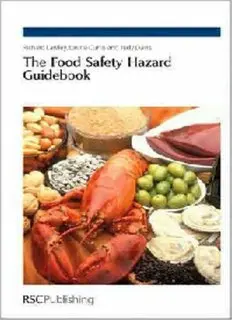
The Food Safety Hazard Guidebook PDF
Preview The Food Safety Hazard Guidebook
The Food Safety Hazard Guidebook The Food Safety Hazard Guidebook Richard Lawley, Laurie Curtis & Judy Davis Food Safety Info, London, UK ISBN: 978-0-85404-460-3 AcataloguerecordforthisbookisavailablefromtheBritishLibrary rRichardLawley,LaurieCurtis&JudyDavis,2008 Allrightsreserved Apart from fair dealing for the purposes of research for non-commercial purposes or for privatestudy,criticismorreview,aspermittedundertheCopyright,DesignsandPatents Act1988andtheCopyrightandRelatedRightsRegulations2003,thispublicationmaynot be reproduced, stored or transmitted, in any form or by any means, without the prior permissioninwritingofTheRoyalSocietyofChemistryorthecopyrightowner,orinthe case of reproduction in accordance with the terms of licences issued by the Copyright LicensingAgencyintheUK,orinaccordancewiththetermsofthelicencesissuedbythe appropriate Reproduction Rights Organization outside the UK. Enquiries concerning re- productionoutsidethetermsstatedhereshouldbesenttoTheRoyalSocietyofChemistry attheaddressprintedonthispage. PublishedbyTheRoyalSocietyofChemistry, ThomasGrahamHouse,SciencePark,MiltonRoad, CambridgeCB40WF,UK RegisteredCharityNumber207890 Forfurtherinformationseeourwebsiteatwww.rsc.org Preface Food safety is important. Consumers have a right to expect that those who supply the food that they buy have taken every care to manufacture products thatwilldothemnoharm.Thosewitharesponsibilityfortheregulationofthe global food industry recognise this principle and legislate accordingly. This confersalegalandamoralduty,aswellasaneconomicincentive,onallfood businesses to ensure that the food they supply is as free from food safety hazards as is practically possible. The food business that tries to evade its re- sponsibilities in this regard will not remain in business for very long. Thebusinessofmanagingandregulatingthesafetyofthefoodsupplychain has come a long way in the last 25 years or so. Prompted by the emergence of new food safety hazards, such as the bacterial pathogens Listeria mono- cytogenes and E. coli O157, powerful new techniques for evaluating and managing the risks presented by these threats have been developed. For ex- ample,hazard-analysiscriticalcontrolpoint,orHACCP,hasnowbecomethe food safety management system of choice worldwide. Similarly, the technique of risk assessment has been developed to the point where it can be applied to almost anything. There now exists a comprehensive toolbox of techniques for managing the safety of food, and a plethora of training and guidance options for learning how to use the tools. As a result, there is now little to excuse any food business that fails to protect its customers from known food safety hazards. Although the food safety management tools are now widely available, they are still virtually useless unless they are supported by adequate and accurate information. HACCP does not work unless its practitioners have access to enough data and scientific knowledge to enable them to understand hazards and how to control them effectively. For example, there is little point in de- cidingthatpasteurisationisthebestwaytocontrolabacterialpathogenunless its heat resistance is known. There is plenty of information available, in countless excellent books and other publications, and increasingly on-line. TheFoodSafetyHazardGuidebook ByRichardLawley,LaurieCurtis&JudyDavis rRichardLawley,LaurieCurtis&JudyDavis,2008 v vi Preface Unfortunately, accessing that information can be problematic, especially for smaller food businesses. TheFoodSafetyHazardGuidebookisanattempttoaddressthatproblemby distillingthekeyfactsaboutawiderangeofindividualfoodsafetyhazardsinto asingletext.Wehavetriedtoadoptaclearformatandtokeeptheinformation includedasconciseaspossiblesothatitiseasytofindtheimportantfacts.We would not claim for one moment that the book is a comprehensive or ex- haustive reference work on food safety hazards, and it is not meant to be. As the title suggests, it is intended as a guidebook rather than an encyclopaedia, andhasbeenconceivedasaportalfortheimmenseandever-expandingbodyof scientific knowledge that exists for food safety. To that end, we have included ‘‘sources of further information’’ in every chapter for those needing more de- tail. As authors, we have drawn on our experience of supplying the technical and scientific information that food safety professionals require to address a real need for accessible knowledge. We have tried to produce a book that is accurate and reliable, as up to date as possible, and above all, useful. Disclaimer The material contained in this book is presented after the exercise of every possible care in its compilation, preparation and issue. However, the authors can accept no liability whatsoever in connection with its application and use. Contents Introduction 1 Section 1: Biological Hazards Chapter 1.1 Bacteria 1.1.1 Aeromonas Species 9 1.1.2 Arcobacter 13 1.1.3 Bacillus Species 16 1.1.4 Campylobacter 21 1.1.5 Clostridium botulinum 25 1.1.6 Clostridium perfringens 32 1.1.7 Enterobacter sakazakii 38 1.1.8 Enterococci 42 1.1.9 Listeria 45 1.1.10 Mycobacterium avium Subsp paratuberculosis 51 1.1.11 Plesiomonas shigelloides 55 1.1.12 Pseudomonas aeruginosa 58 1.1.13 Salmonella 60 1.1.14 Shigella 66 1.1.15 Staphylococcus aureus 70 1.1.16 Streptococci 75 1.1.17 Verocytotoxin-Producing Escherichia coli (VTEC) 78 1.1.18 Vibrio cholerae 84 1.1.19 Vibrio parahaemolyticus 88 1.1.20 Vibrio vulnificus 93 1.1.21 Yersinia enterocolitica 97 1.1.22 Yersinia pseudotuberculosis 101 1.1.23 Other Enterobacteriaceae 104 TheFoodSafetyHazardGuidebook ByRichardLawley,LaurieCurtis&JudyDavis rRichardLawley,LaurieCurtis&JudyDavis,2008 vii viii Contents Chapter 1.2 Viruses 1.2.1 Astroviruses 107 1.2.2 Hepatitis A Virus 110 1.2.3 Hepatitis E Virus 114 1.2.4 Highly Pathogenic Avian Influenza Viruses 118 1.2.5 Noroviruses 123 1.2.6 Parvoviruses 127 1.2.7 Rotaviruses 129 1.2.8 Sapoviruses 133 Chapter 1.3 Parasites 1.3.1 Protozoa 136 1.3.1.1 Cryptosporidium 136 1.3.1.2 Cyclospora 141 1.3.1.3 Entamoeba 145 1.3.1.4 Giardia 149 1.3.1.5 Toxoplasma 153 1.3.2 Nematodes 158 1.3.2.1 Anisakids 158 1.3.2.2 Trichinella 162 1.3.3 Other Parasites 167 Chapter 1.4 Prions 172 Section 2: Chemical Hazards Chapter 2.1 Biological Toxins 2.1.1 Fungal Toxins 179 2.1.1.1 Aflatoxins 179 2.1.1.2 Citrinin 185 2.1.1.3 Cyclopiazonic Acid 188 2.1.1.4 Deoxynivalenol 191 2.1.1.5 Ergot 196 2.1.1.6 Fumonisins 200 2.1.1.7 Moniliformin 205 2.1.1.8 Ochratoxins 208 2.1.1.9 Patulin 213 2.1.1.10 Sterigmatocystin 217 2.1.1.11 Trichothecenes 219 2.1.1.12 Zearalenone 224 2.1.1.13 Other Mycotoxins 228 Contents ix 2.1.2 Plant Toxins 233 2.1.2.1 Cucurbitacins 233 2.1.2.2 Cyanogenic Glycosides 235 2.1.2.3 Furocoumarins 239 2.1.2.4 Glycoalkaloids 242 2.1.2.5 Grayanotoxin 247 2.1.2.6 Lectins 249 2.1.3 Fish Toxins 253 2.1.3.1 Amnesic Shellfish Poisoning (ASP) 253 2.1.3.2 Azaspiracid Shellfish Poisoning (AZP) 257 2.1.3.3 Ciguatera Fish Poisoning 260 2.1.3.4 Diarrhoeic Shellfish Poisoning (DSP) 264 2.1.3.5 Neurologic Shellfish Poisoning (NSP) 268 2.1.3.6 Paralytic Shellfish Poisoning (PSP) 272 2.1.3.7 Tetrodotoxin 276 2.1.4 Biogenic Amines 279 2.1.4.1 Biogenic Amines (Excluding Histamine) 279 2.1.4.2 Scombrotoxin (Histamine) 283 Chapter 2.2 Non-Biological Contaminants 2.2.1 Contaminants Produced During Processing 288 2.2.1.1 Acrylamide 288 2.2.1.2 Benzene 293 2.2.1.3 Chloropropanols 296 2.2.1.4 Furan 300 2.2.1.5 Polycyclic Aromatic Hydrocarbons 303 2.2.2 Contaminants from Food-Contact Materials 307 2.2.2.1 Bisphenol A 307 2.2.2.2 Phthalates 311 2.2.2.3 Semicarbazide 316 2.2.3 Environmental Contaminants 320 2.2.3.1 Dioxins and PCBs 320 2.2.3.2 Heavy Metals 325 2.2.3.3 Perchlorate 333 2.2.4 Veterinary Residues 336 2.2.4.1 Antibiotics 336 2.2.4.2 Hormones 341 Section 3: Allergens Chapter 3.1 Food Allergy 349 Chapter 3.2 Specific Allergens 3.2.1 Celery Allergy 353 3.2.2 Hen’s Egg Allergy 356
